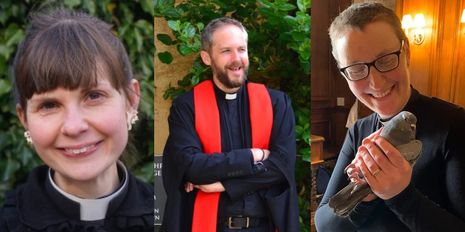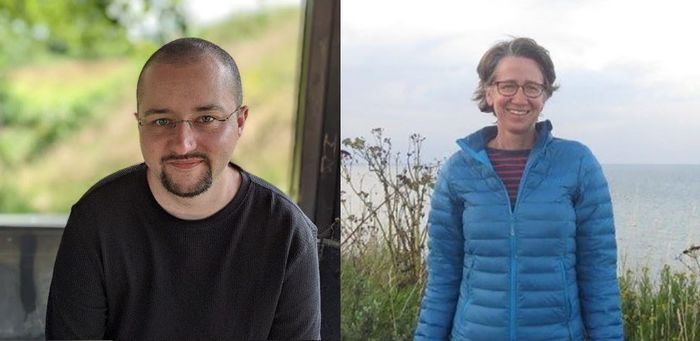‘Here for all’: our college chaplains
Joshua Gleave talks to college chaplains across Cambridge about their unique job role and its accompanying set of highlights and challenges

In 1355, Pope Innocent V gave Marie de St Pol, the Foundress of Pembroke College, permission to build Cambridge’s first college chapel. With this chapel came a person: Cambridge’s first college chaplain. Today, almost 700 years later, this special tradition of employment is still with us, though not without its challenges.
For many years now, almost all college chaplains have been Anglican priests. Today, many associate the institution they represent with harmful actions and ideas – especially young people. Navigating this in a university setting “can be one of the biggest challenges” for a college chaplain, says the Rev’d Ally Barrett at St Catharine’s. College chaplains can find themselves having to answer for a Church embroiled in controversy: for instance, while queer students may represent 50% of a college’s intake, the Church of England continues to reject gay marriage. On that issue, change is tangible, but slow. Nonetheless, Ally suggested there is “a lot of worth” in working within a divided Church, as she does, while it remains open to change.
"College chaplains can find themselves having to answer for a Church embroiled in controversy"
I also asked the Rev’d Arabella Milbank Robinson, Selwyn’s chaplain, about her approach to representing the Church. Her goal is “representing Christ” and “finding Christ in others, more than representing the Church in the way a politician does a political party.” Nonetheless, she insists on the Church’s “all-embracing” nature and tries not to “play into” its divisions. “I am part of my Church”, she reflects: “[I can’t] pretend to just be ‘one of the nice ones’ and bracket myself out!” And, like Ally, she voices a willingness to have difficult conversations with her college community.
Chaplains not only face challenges from the student community, but also from the wider Church. Certain priests accuse them of abandoning parish ministry, says the Rev’d Hugh Shilson-Thomas, Selwyn’s recently retired chaplain. Chaplains avoid the “births and baptisms”, the “marriages and marriage breakdowns”, and the “endless funerals” that mark the days of a parish priest, as my own chaplain at Corpus Christi, the Rev’d Matt Bullimore, described them. Instead, however, chaplains care for a group rarely seen in parish pews: young adults, who are the “inverse of who I encountered in the parish”, Matt says.
This poses unique challenges: a college chaplain deals with anything from life aspirations, to the worries of student debt, and even, as Matt recalls, dating advice! Arabella noted that, unlike her work in the parish, her work in college entails far more contact with “all faiths and none”. For her, this is very much a positive: “I am necessarily here for all,” she says, “and rejoice to embrace this.”
The first priorities of a chaplain are pastoral and spiritual, not academic. In the 1960s, Oxford had no college chaplaincy of this sort, while Cambridge did – hence Cambridge’s healthier chapel life, thought the Bishop of Woolwich. Likewise, Trinity Hall’s chapel life was in neglect for over a century without a dedicated chaplain: until one was appointed in 1856, clerical duties fell to a few academic fellows. In other words, chapels need chaplains.
“I am necessarily here for all, and rejoice to embrace this.”
Chaplaincy is not, however, confined within the chapel’s walls. Each week, Matt leads four lots of morning and evening prayer, two evensongs, and a mass. He sets up, he puts away, and so on. With related tasks like sermon writing, these chapel activities only add up to around 14 hours per week. Many more of a chaplain’s hours are spent on more self-determined pursuits: Ally showed me a whole mind map of her activities, covering sustainability, wellbeing, and EDI (equality, diversity, and inclusion).
Traditionally, as Ally points out, a priest is not paid for what they do; instead, they receive a “stipend”. This money covers their living expenses. So, they are free to pursue their ministry – wherever and as far as it may take them. Matt’s work, beyond Chapel, is “to enact a Christian presence within the [college] institution more broadly”. As he puts it, chaplaincy in large part means hospitality: “being available to people, making time for people.” Arabella tells me that Christ leads her to see people “in ways the ‘institution’ doesn’t”: not as “their college roles or research projects or triposes”, but as “infinitely, eternally precious” individuals.
Many colleges list “advancement of religion” among their official charitable objectives. This longstanding commitment is, among other things, financial. Over 500 years ago, John Warkworth, Peterhouse’s master, funded the hiring of a College chaplain, who he demanded be “virtuous, poor, and disposed to study”. 300 years later, a statute from Downing allotted its chaplain half the stipends of an academic fellow. And today, still, the college usually pays the chaplain, not the Church of England. Stipends often mirror those of a vicar.
Even so, a chaplain’s loyalty to their college is conditional: it runs “to the extent that it doesn’t go against your vocation as a priest”, Matt told me. Duty to the college is secondary to the Church. Actual clashes, however, seem to be very rare – largely hypothetical, even. Is this lack of conflict a result of good institutions, Ally wonders, good people working within them for resolution – or both?
Ultimately, I was told, a priest answers to God, not an institution. And for Arabella, “that’s an allegiance, a loyalty, that is above any other”.
 News / Cambridge students set up encampment calling for Israel divestment6 May 2024
News / Cambridge students set up encampment calling for Israel divestment6 May 2024 News / Cambridge postgrad re-elected as City councillor4 May 2024
News / Cambridge postgrad re-elected as City councillor4 May 2024 News / Some supervisors’ effective pay rate £3 below living wage, new report finds5 May 2024
News / Some supervisors’ effective pay rate £3 below living wage, new report finds5 May 2024 Fashion / Class and closeted identities: how do fits fit into our cultures?6 May 2024
Fashion / Class and closeted identities: how do fits fit into our cultures?6 May 2024 News / Academics call for Cambridge to drop investigation into ‘race realist’ fellow2 May 2024
News / Academics call for Cambridge to drop investigation into ‘race realist’ fellow2 May 2024






